Introduction
As the old saying goes, “you can’t polish a turd, but you can roll it in glitter”. The same goes for websites too. If you are designing a new website and the majority of your scoping session is spent discussing styling, then the chances are your website is going to be a bit… poo!
In this article, I’m going to show how important it is to design a website that functions well, and how much of that is down to a solid foundation of research and strategy. I will explain how the different processes inform our decisions and look at some of the tools we use.
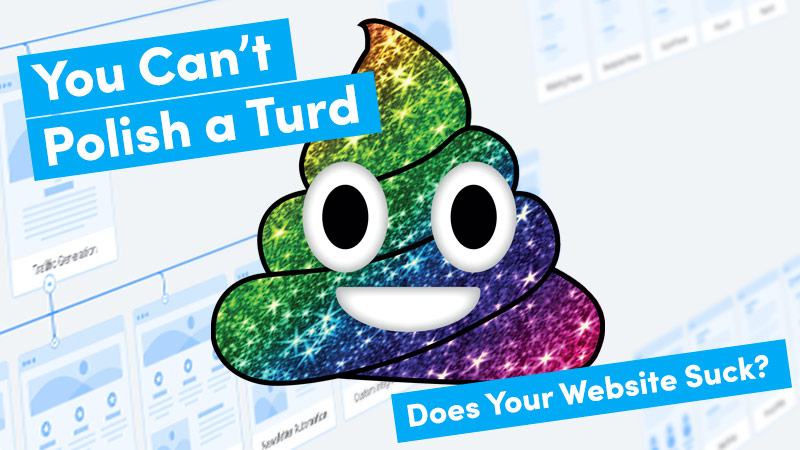
“You Can’t Polish a Turd, But You can Roll it in Glitter”
Do you need a new website?
Contact our lovely team today!
First Impressions Count
It is true that first impressions count. In fact, a visitor will make snap judgments about your website within 0.05 seconds. This will influence how they feel about your brand and how much they trust you and want to buy from you. Therefore, having a visual design that matches your brand and value proposition is essential.
If you want to know what your visitors’ first impressions of your website are at the moment, try conducting the 5-second test. This is a user test where you show a webpage to a participant from your target audience for 5-seconds and then get them to answer questions like these:
- What is the purpose of the page?
- What are the main elements you can recall?
- Who do you think the intended audience is?
- Did the design/brand appear trustworthy?
- What was your impression of the design?
Is a good visual design all you need for a successful website?
So, now we know we have a beautiful website, we can all celebrate a job well done and watch the revenue pour in, am I right? Nope! Wrong! Although a good first impression is important, if the experience of using the site is frustrating, then visitors will leave and may never come back.
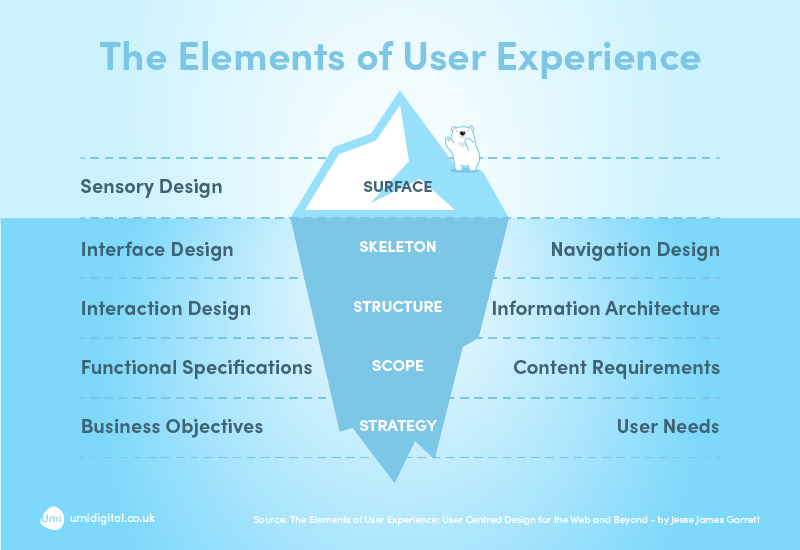
Elements of User Experience
Think of a website as an iceberg, you may only be able to see the tip, but in fact there is a whole lot more going on below the surface. In Jesse James Garrett’s book ‘The Elements of User Experience’ he lists the five planes that are essential to designing a good user experience as:
- Strategy
- Scope
- Structure
- Skeleton
- Surface
The key to a successful website is to start with a clear strategy and then, in turn, each plane will inform the other. Therefore, to design a truly successful surface to your website, you must have first taken into consideration the first four planes.
What are the website’s goals?
A good website strategy has to take into consideration both business objectives and a user’s needs. In general terms, any business will have goals that look like this:
- Increasing revenue
- Decreasing costs
- Increasing market share
- Increasing value of existing customers
- Increasing shareholder value
But how can your website help you achieve these? In the early days of commercial websites, they were just versions of your glossy brochure, hence the term ‘brochure website’. Therefore, the only goal that it could be expected to achieve was to create a good first impression.
However, these days, modern websites can do much more than that. They have to integrate with social media, email marketing and lead generation in a seamless experience for the user, with the aim of turning visitors into loyal customers. Therefore, some of your website’s goals might be:
- Introducing your business to new customers
- Selling existing products to more people
- Creating brand new products to sell
- Growing an email list
- Growing your social media followers
- Becoming more recognised in your industry
- Supporting customers with answers to their problems
- Building a brand identity
OK, so now we understand what the business is trying to achieve, but how do we find out what the user’s need from our website? For this we need to conduct some user research.
Conducting the Right User Research
There are many different methods of user research you can use when trying to create a great user experience. Hubspot’s Growth-Driven Design strategy arranges the many methods into three categories; Qualitative, Observational and Quantitative.
| QUALITATIVE | OBSERVATIONAL | QUANTITATIVE |
|---|---|---|
| User Interviews | Click Heatmaps | Website Analytics |
| User Surveys | Scroll Heatmaps | Website Event Tracking |
| Website Chat | User Recording | Website Funnel Reporting |
| User Testing | Website Cohort Reporting |
A great way to understand what your target user wants from your website is try some of the qualitative methods.
Website Chat
If you have website chat installed on your site, you can analyse the transcripts to see what the most common questions are.
User Surveys
Sending a customer survey to someone who has just purchased from your website is a fantastic way to understand what actual paying customers want from your website. This is a great way to define between actual customers and simply visitors to the website. Hotjar is a great way to ask questions on your site, whilst Google Forms is a great way to send a survey to customers who have just purchased.
User Testing
Observing someone using your website and asking them to think aloud helps you to see the website from the users point of view. It can be amazing how blind you become to glaring issues when you use it daily and know where everything is. Conducting just 3-5 usability tests will highlight a tonne of improvements that can be made to improve the user experience of your website.
Communicating Your Strategy Clearly
If your website is going to be successful in achieving the goals of your website strategy, it is essential that everyone on your team is on the same page. Being able to visually communicate your digital strategy clearly is a great way to get everyone aligned on what needs to be done to achieve this. Here are some tools we use:
Personas
Creating a persona allows everyone on the team to be able to understand and empathise with who your ideal customer is, as if they were a real person.
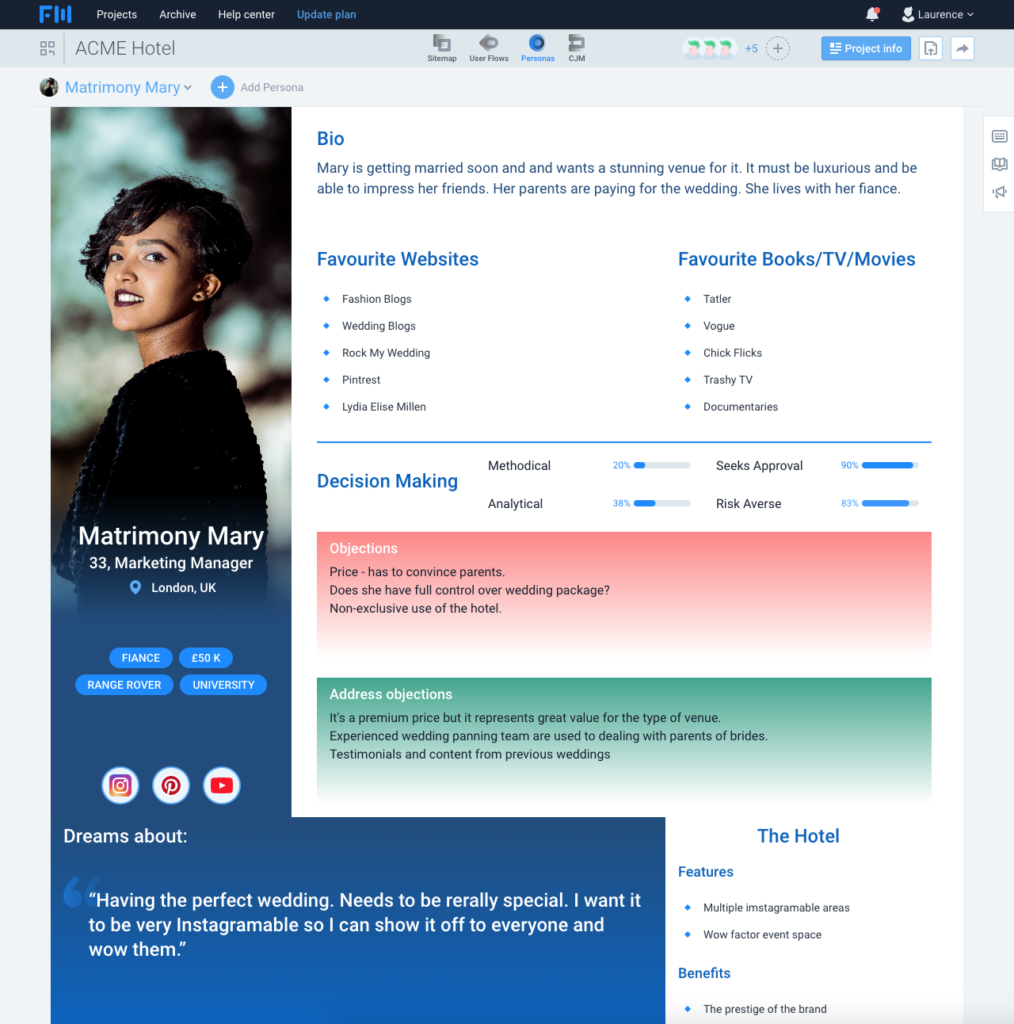
Persona Template Flowmapp
Jobs-to-be-Done
Defining the job the user is trying to get done is essential to creating a great user experience, but it is quite often ignored and misunderstood. I explain it fully in The Ultimate Guide To Digital Marketing For Hotels:
“For example, a person goes to a DIY store to buy a drill. What is the job-to-be-done in this scenario? Is it to buy a drill? No, not quite. We need to look at what they are looking to buy the drill for. Drills make holes. So, making a hole is the job-to-be-done, right? Nope, but we’re getting closer.
If you ask why they need to put a whole in the wall, you’ll be in a better position to make the best recommendation. It turns out they need to hang a picture frame. In this case, they could buy a hammer and some nails or even a no-nails sticky hook. These might be also products that we sell, or they could be competing alternatives.”
Customer Journey Map
Now we understand what the visitor’s JTBD (“job-to-be-done”) is, we can map out the journey they take to make a decision and purchase something. For this we use the Customer Journey Map and it has four stages:
- Awareness
- Consideration
- Decision
- Delight
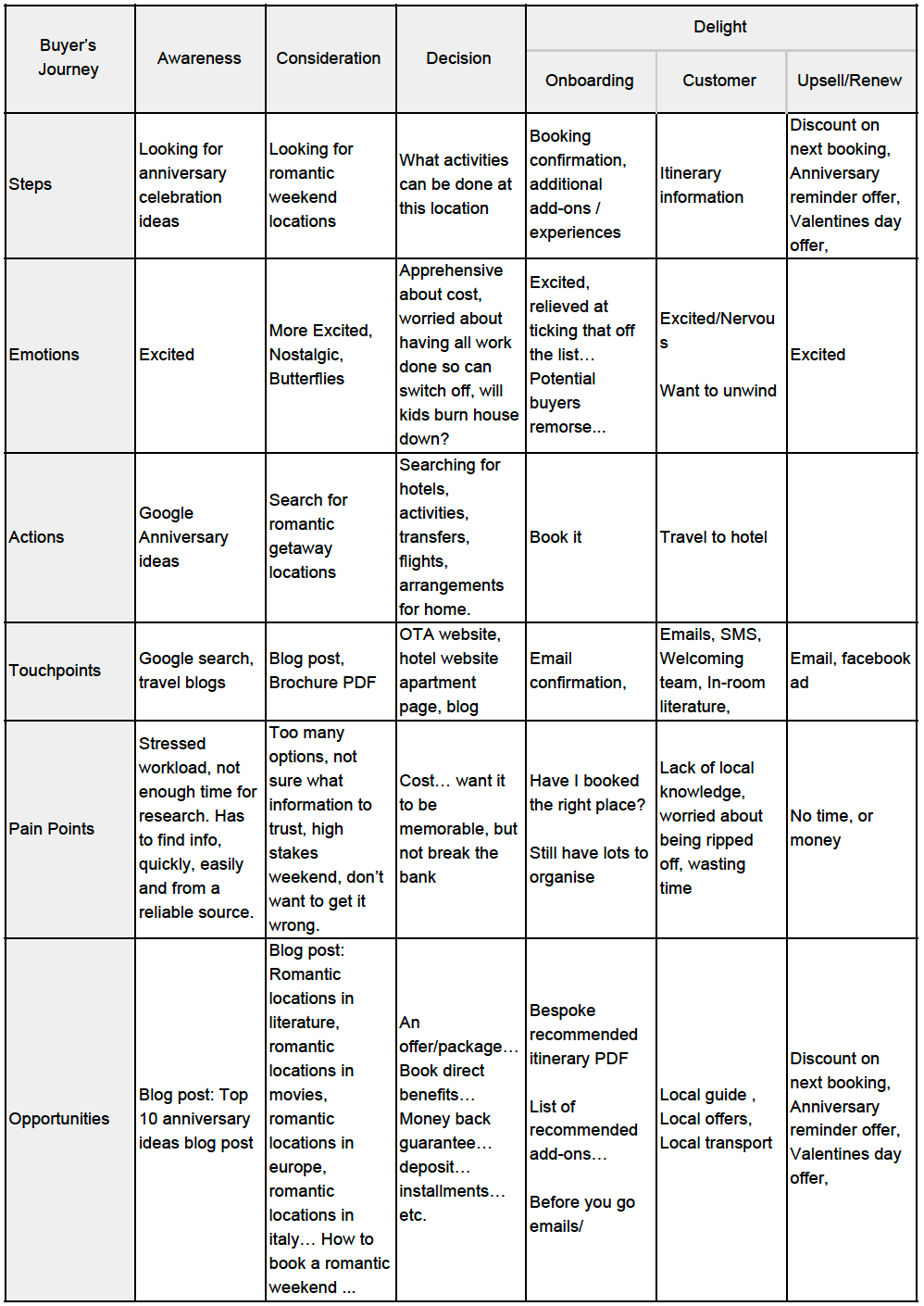
Customer Journey Mapping for Hotels
A customer journey map essentially outlines your sales funnel. The aim is to optimise the sales funnel so that it is better at converting visitors into customers. To help us do this, we like to use a tool called Funnelytics.
Sitemap
Now that we have a better understanding of the journey a users need to take in order to become a customer and we have mapped out the sales funnels for our different revenue streams, it is time to create a sitemap for our entire site. This enables everyone to see the big picture. For this we use Flowmapp.
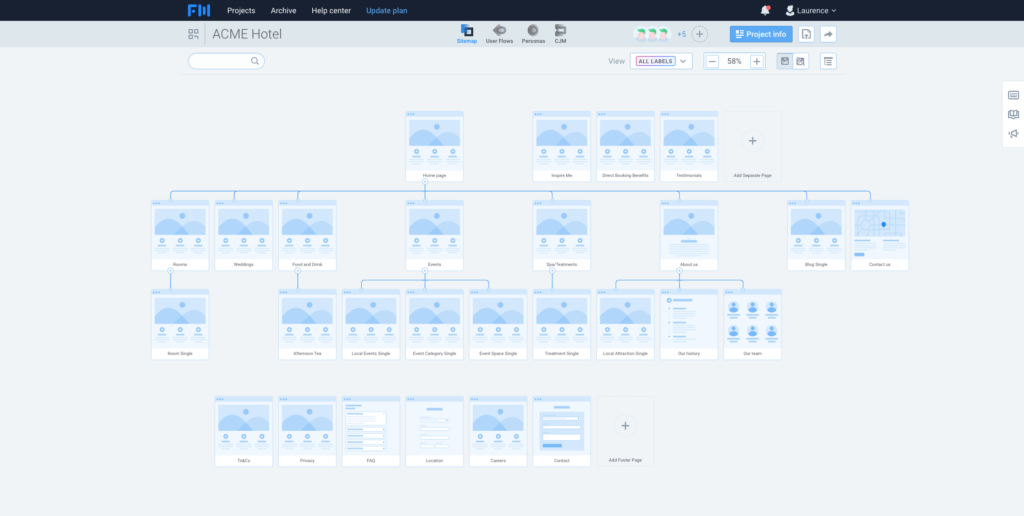
Sitemap Flowmapp
Wireframes
Once we have the sitemap planned we can really start bringing the website to life by creating a wireframe. The wireframe allows us to see what structure the pages will take before any surface styling has taken place. We use Adobe XD to create our wireframes and they can be used as clickable prototypes before any coding has taken place. Conducting a user test on a clickable prototype, can be a great way to see how good your user experience is before any styling has been done. A great tool for conducting remote user tests is UserTesting.com
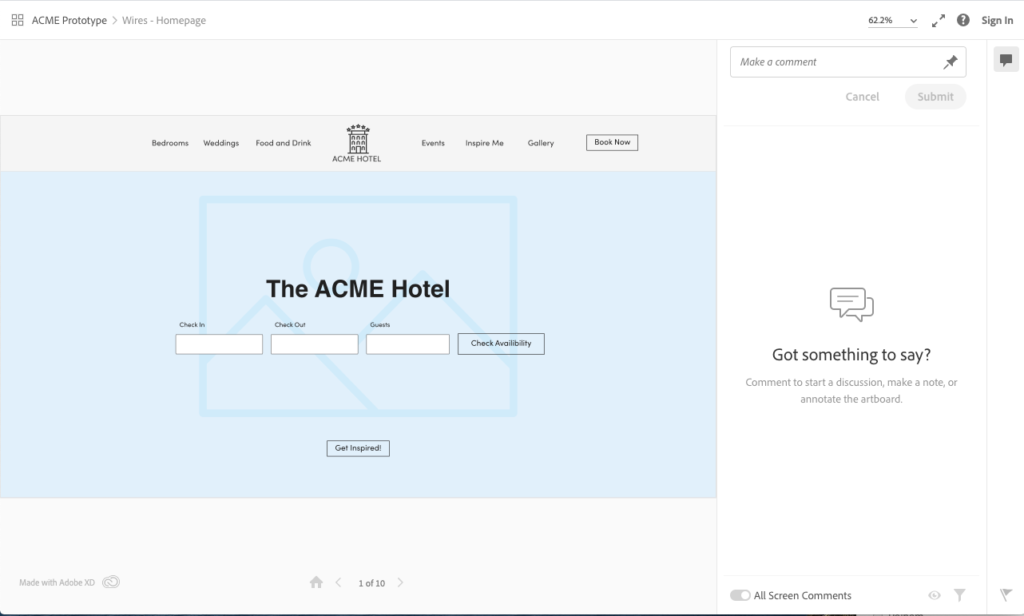
Clickable Prototype AdobeXD
Conclusion
Whilst the visual design of your website on the surface is essential to giving the right first impression, it is just the tip of the iceberg. There is a lot more going on beneath the surface that is helping guide your visitors along their journey to becoming your customer, meeting their needs and achieving your business objectives. At the heart of this is the right amount of user research and a strategic process.
If you would like us to help you design a website that achieves your business objectives and meets your user’s needs then get in touch.
Do you need a new website?
Contact our lovely team today!





